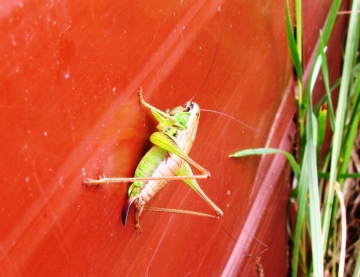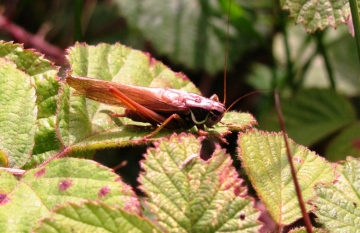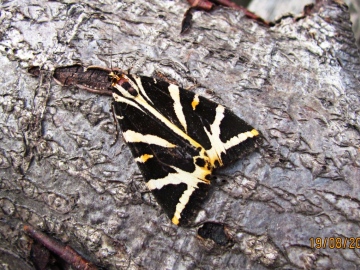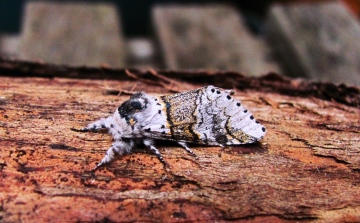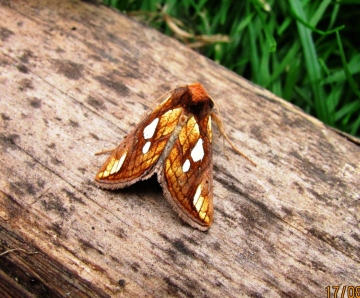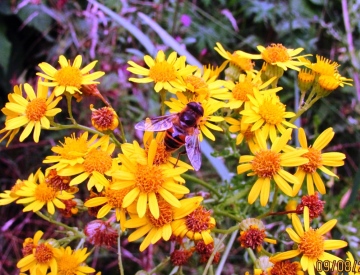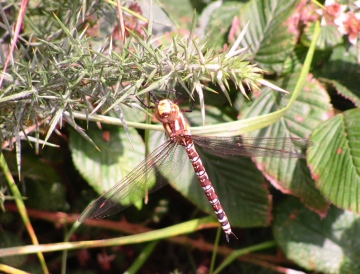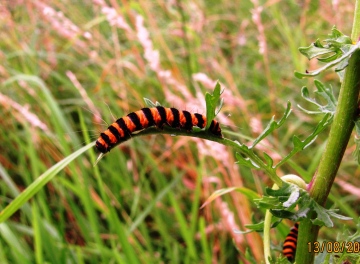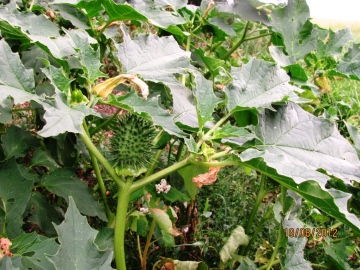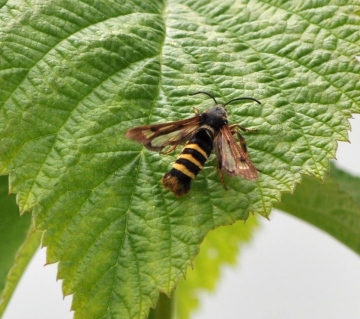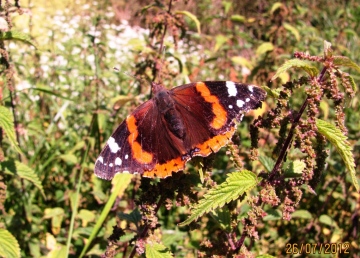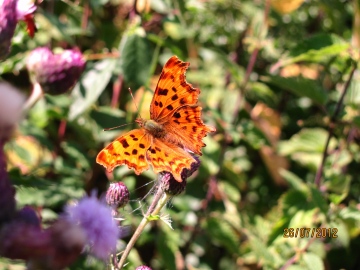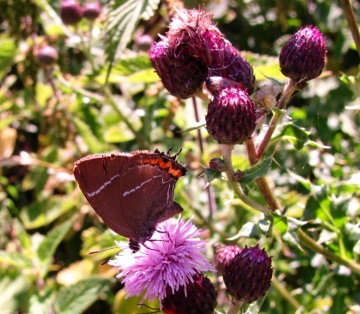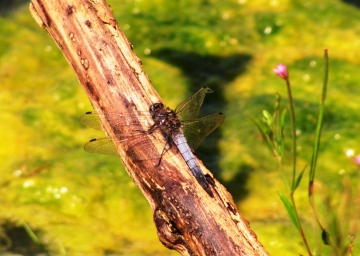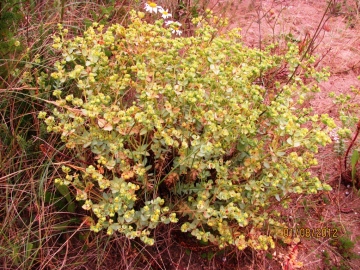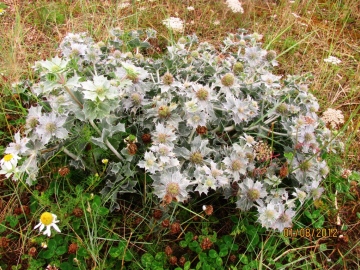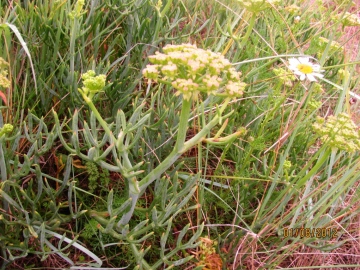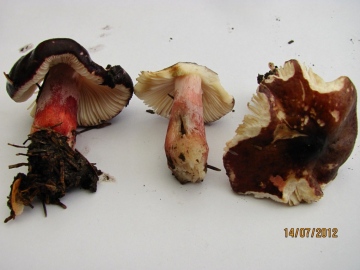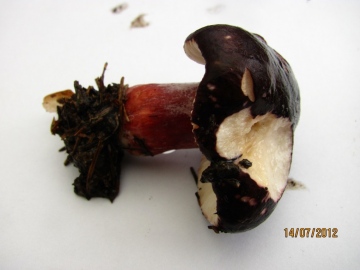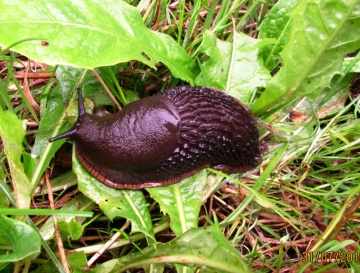Your Forum
The weblog below is for naturalists to use to report interesting sightings, ask questions, report on field meetings and generally post pictures and any information or questions generally relevant in some way to the wildlife and geology of Essex. You will need to register and be logged-on to post to the forum, and you need to upload pictures first, for use in posts. Find out more
|
Fri 31st August 2012 21:33 by Mary Smith Sorry, I am late joining in....
... to the discussions about different kinds of animals affected by this year's strange weather. Apart from Queen wasps in late March (a heat wave, do you remember??) we have not seen a single one in our garden since. No young birds learning to fly have been seen here, as I gather most of them died in their nests of starvation as the parents could not find food for them. Butterflies were very scarce at home until the second week in August when the sun came out of hiding for a couple of weeks, when suddenly they were everywhere, but only a few kinds, I think. However, we have ants' nests in our 'lawn', some of which have been there for some time (indication of unimproved grassland, I suppose). But we have at least 5 new ones this year, all heaving with burgeoning thousands of ants. I would have supposed that ants would have a hard time in a soggy season, especially ones in lawns, but the opposite seems to be true. Does anyone have any explanations for this?
And plants are still behind their usual times. Late-flowering ones like Blue Fleabane came into flower in April (yes, really!), but lots of later ones are still not in flower, especially the variations on Michaelmas daisies, and the alien grasses that are usually late but were still not in flower in late August ie two days ago.
And the met office tell us it has been the coldest and wettest summer for about 100 years. We would never have guessed, would we??!! Mon 27th August 2012 15:44 by Peter Pearson Thanks for the ID Graham
Square-Spot Rustic - another name to remember Below are a couple of shots, taken in the garden yesterday, I thought may be of interest particularly to Peter H. 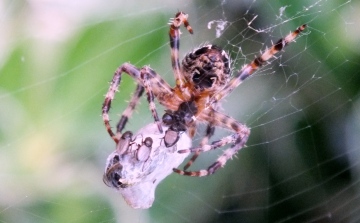 I was drawn to a silvery flash in the sunlight, shining on a lavender in the back garden and noted a Garden Spider had constructed a strategically placed web across the path used by Honey Bees. A bee had obviously been entrapped and the flash was the rotating corpse being encased in silk as the spider finished packaging it. Close inspection revealed that the spider was having problems with flies, yes flies small black ones (sp?). The size can be seen compared to the size of the bee. As it rotated its prey the flies persisted in landing on the encased bee. The spider plucked at the web, vibrating it, frightening the flies off briefly, they returned in an instant. It even tried to brush them aside with its feet, to no avail. The flies seemed absolutely oblivious and unaffected by the web flying through it without becoming entrapped themselves. Eventually the spider gave up and left the prey to the flies. I was left wondering what it was that attracted the flies in the first place. They were interested in the head end of the prey and only conclusion I could come to was that the bee had been storing nectar to take back to the nest. This was released as the result of sedation by the spiders venom and soaked into the surrounding silk. I would be interested to hear comment on this observation and whether it happens commonly. Sun 26th August 2012 19:21 by Graham Smith Snails and what not
Peter - a very fine specimen indeed but I bet I can find a fatter one! The single Purple Sprouting that survived the slugs and snails has now been completely shredded by Small White caterpillars, which are now reduced to eating the leaf stalks. I fear the smaller ones will starve unless they rapidly develop a taste for something new - my parsnips probably.
Like you, I have seen very few ladybirds this summer, although there were loads around in March. Aphids are the one pest that has not been a problem in my garden this year so perhaps they are having a bad summer too! Grasshoppers are also very sparse - a long walk round Mill Green today produced very few. Crickets seem to be doing a little better, especially Roesel's Bush Cricket. These two shots depict the short-winged form, taken at Blue House in July, and the long-winged form, photographed at The Hyde Lake, Ingatestone this month. I have always presumed that the latter form is produced when pressure of numbers prompts a dispersal strategy but I am probably wrong on this. Alas, I can hear neither crickets or grasshoppers anymore. Your moth by the way is a Square-spot Rustic, a common species at this time of year in gardens. The following is not, at least away from the London area. It is a Jersey Tiger, a species once confined to - no, not the Channel Islands - but Devon (hence its name!) but which has spread northwards into the metropolis recently; so recently that there is no mention of the fact in my 2003 copy of the Moths of GB and Ireland. I'm not sure how far north they have got in the county - I will have to look it up on the database - but a lovely surprise when opening the trap one morning. Fri 24th August 2012 20:22 by Peter Pearson Bean Raiders
At last Graham I've traced the culprit raiding the runners, caught on it's way to the crime scene not the Giant Slug but the below 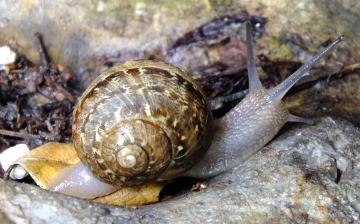 Yes the common all garden snail. Not good on moths but is this a Hedge Rustic. It came indoors when the lights were on. 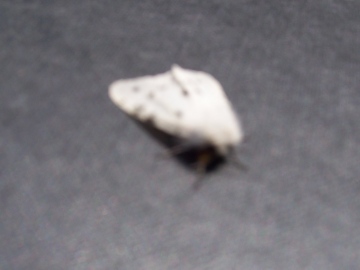 Finally caught this last pic on a walk searching for insects along Skinners Wall, Manningtree. No Insects but plenty of Egrets which led to this dispute over fishing rights Fri 24th August 2012 11:07 by Graham Smith Hedgehogs, Ladybirds and depleted wildlife
Peter - you are lucky to have regular visits from Hedgehogs as they are very thin on the ground in the Ingatestone area. Twenty years ago it was nothing to find 30+ squashed on the road during the course of a summer but I seldom see them nowadays. It would be nice to think that they had read the highway code since those days but somehow I doubt it! The only one I have seen this year had obviously been clipped by a car. It was huddled up against a garden wall and some kind person had put out saucers of food and water for it but I fear that it was unlikely to recover. Have found droppings in the garden on a couple of occasions lately so one may have taken up residence. If so, then it should be nice and fat by the time it needs to hibernate as there are hundreds of slugs for it to feast upon. Incidentally, I have found that the only way to preserve my runner beans is to go out at dusk with a trowel, gather up all those heading for the poles and then deposit them at the far end of the garden. It takes them all night to walk back again, by which time they have to hide up for the day. My theory is that after three nights of this they get so fed up that they stay put and eat something else! It seems to have worked as I have had a fair crop of beans - very tasty ones - but as usual I cannot remember the variety I planted!
Also present at dusk on these long overdue summer evenings has been a couple of Pipistrelle bats. A friend brought a bat detector one evening and this suggested that they were Soprano (as opposed to Common) Pipistrelles. Brown Long-eared Bats also occur in the garden as my neighbour once brought me one that he found clinging to the wall of his house during the day. Another was handed to me by someone who - bizarrely - found it clinging to one of the old type granite kerb-stones in Ingatestone High Street. On 12th, on Michael's advice, my bat watching extended into the early hours - it is usually far too warm to sleep much before midnight anyway on these sultry evenings we have experienced lately - and was rewarded with the sight of several shooting stars, there being only patchy light cloud. Thanks Michael. As for the lack of insects, wasps are certainly very low in numbers. There were lots here in the early spring, presumably all Queens, and they seemed to be feeding on the sap oozing from the buds of the Norway Spruce. Have hardly seen one since. Sometimes they can be a real nuisance when moth trapping as they enter the box in search of prey, mostly the little grass moths that can occur in hundreds in midsummer, but occasionally larger species. They clip the wings off the latter before carting them off to their nests. Neither have I seen a single Hornet this summer. A couple of years ago, whilst helping with a 'moth night' at Epping Field Centre, I brought the trap inside at the end of the evening to open it up and around 30 Hornets flew out! Fortunately, they are not as bolshy as wasps. I was once stung on the tongue by a dead wasp while eating a home made mince pie that had been baked the previous day. Feeling your tongue swelling inside your mouth to a size that feels akin to that of a tennis ball is not a pleasant experience but a jab in the backside soon put me right. My grandfather was not so lucky as he was stung in the throat as a young man and nearly died, spending several days in hospital. Had he succumbed then I would not be here writing this. What a sad thought! It is not just insects that have fared badly this wretched spring.The BTO reports that for many species it has been the worst breeding season they have records for - and they were founded in the 1930s. However, now that better weather has arrived in south-east England (but not in the north and west) a few insects have picked up in numbers, including moths; the equally beautiful Sallow Kitten and Gold Spot, below, being caught in my garden and at Blue House respectively. Hoverflies have also responded to the warmer weather, including this Drone Fly Eristalis tenax, photographed in the garden; another was snapped up and eaten by a Southern Hawker, photographed at Fryerning Churchyard a couple of days later. Finally, no invasive plants in the garden this year apart from Ragwort, which I encourage as it is the food plant of the Cinnabar moth, a caterpillar of which is pictured below. There was, however, a fine display of Thorn Apple (formerly knlown as Apple of Peru) beneath the bird feeders outside the Bird Observatory at Bradwell. This species originates in South America but has successfully accompanied man on his travels throughout the world. Wikkipedia informs me that it is used in herbal medicine to relieve asthma symptoms and as an analgesic during surgery and bone setting. It is also a powerful hallucinogenic and produces intense visions. I did think of using to conjour up visions of a countryside where Turtle Doves, Spotted Flycatchers, Cuckoos, Tree Sparrows and the like abounded once more but the tropane alkaloids it contains, which are responsible for both the medicinal and spiritual properties, are fatally toxic when imbued in even tiny amounts above the recommended level - so perhaps not! Wed 22nd August 2012 20:05 by Peter Pearson Hedgehogs
Michael, We are fortunate with Hedgehogs, having fed them in the garden over several years we often have one waiting in the garden particularly if we are late home, 'come on where have you been' . A few nights ago a neighbour was woken up by grunting noises and looking out saw three, two of which were making the grunts and having a pushing match while the third looked on, obviously two males competing for a female. We appear to have quite a few about the area, unfortnately brought to notice by the number of road deaths. Other observations over the years have included Mum with a line of young trailing behind, then one out in the snow, having come out of hibernation, looking for food where they are normally fed. We too have a problem weed a purple leaved variety of what we believe to be Yellow Oxalis Oxalis corniculata it grows everywhere. Originally coming in on plants from the nursery it throws its seed far and wide, as well as sending out creeping tendrils and is an absolute menace. I suppose we all have our crosses to bear. Wed 22nd August 2012 12:13 by Michael Daniels Depleted wildlife
Yes Peter, many more things are in trouble. How much bother we had from wasps, had to look out for these spiteful
insects. Hardly seen any this year or last. So many of the common garden creatures we knew in the past, almost
non existent in these parts. Hedgehogs, were here in quantity and they too disappeared as they have from my cousin's
garden in north London, where he has plenty of the right habitat for this now urban animal. He wonders about slug pellets,
I on wider causes! Tick infestation - I once removed twenty-one of these pretty night-marish pests from one hedgehog!
Sure, hardly any sign of ladybirds this year, and flying ants likewise.
As far as weeds are concerned, no shortage of those and one in particular Peletory-in-the-wall turned up everywhere three years ago and still proliferates. And, where on earth did this plant come to plague us? Just as though some shower brought the seeds and distributed them liberally across our plot, yet not in our immediate neighbours so it seems. Wed 22nd August 2012 07:48 by Peter Pearson Where have all the ladybirds gone
Earlier in the year I wrote on the forum of the large numbers of ladybirds over wintering. Despite the very cold conditions they came through and on dispersal could be be found everywhere. Now they appear to be scarce and very few are to be found, here in N.E.Essex anyway. Is this the same all over the county? Could it be that the cold and extremely wet late spring and early summer has interfered with breeding patterns? There was a report on TV that Bug-Life are concerned about the well being of a number of species due to the wet conditions Butterfly numbers in our garden are very low, Large and Small Whites have been visiting regularly, but others are just very occasional singletons. Painted Ladys are noteable by their absence and only one Silver 'Y' has put in an appearance. It looks to have been a disasterous year all round, except for mosquitos which are being a real pest while trying to sit out on our odd warm evening. Fri 17th August 2012 15:42 by Michael Daniels More controvercy and a mail from Canada
I wrote in response to the topics raised by the faithful small band of contributors who keep the Forum supplied
with interesting viewpoints. I pressed SUBMIT and the piece over which I had laboured disappeared, but did not appear in the website 'post your news' page. Checked with Peter and he was unable to answer that conundrum and now some of what I had to say including comments on the meteors, are now irrelevant.
Also I asked Peter if he thought a mail from our good friend who lives on Vancouver Island might be worth copying into the Forum. This had much to say about present weather conditions across North America. We lived in Canada for a while and certainly know all about the climate there, but it never was as bad as those out there are now experiencing. Anyway Peter agreed that the interest it might raise could induce a few more contributions from a wider circle than just from those who at present keep the Forum active. I don't know about all that commotion from the highway near you Graham, like some even more hellish variant of Stockhausen's compositions. Not wishing to be assaulted by either, but at least you can turn off Stockhausen, not so with traffic and the volume of such gets everyday more alarming. How can we continue in this way, not only on the roads, but everywhere else we look, man seems to be determined to wreck the environment, particularly the thin atmospheric layers that make life possible on this planet. Damaging this as we so certainly appear to be doing, then we will soon enter a catastrophic phase from which there may be no recovery. Already there are clear signs that the process is well underway. In 1815 the volcano Tambora on the island of Sumbawa in present day Indonesia erupted causing world-wide climatic effects - producing what came to be know as 'the year without a summer'. There is plenty to read about this event on the Internet. However, volcanoes usually die down after their initial massive outburst and after a time things return to near normal. But, as one reads about and in many respects actually experience all the strange climatic occurrences now being felt across the world, this time around we cannot blame natural forces for these disastrous effects, we, all of us to a degree, are responsible in one way or another for crucially damaging this world and its fragile environments. The trouble here, is what is the alternative to the way we so irresponsibly conduct our lives, and the forlorn answer seems to be we cannot do anything for what is now in train. Oh yes, some will say this concern is overstated, overly pessimistic. Maybe, but it is worth looking up Tambora and now reading what our good friend in British Columbia has to say. Here she writes and it should be noted she has only recently got into using of her computer, indeed typing - she's doing very well! Came from Loughton originally! From Vancouver Island; and by the way I told her I might like to use it in our website forum. 'Just thought I would send you a few lines. Hope you are both well, as it leaves us here. We need rain badly, all the Lawns are going brown,it been weeks since we had any Rain, in some places they have had to much, land slides,killing 4 people, yesterday in Alberta, they had Hail the size of Tennis Balls, done Millions of Dollars of damage, every Car on the Dealers Car Lots, were full of dents, and all the Windows broken, it was a real mess, everywhere. Saskatchewan, has had 32 Tornado's so far this Year. Manitoba has been hot and dry, lots of crop failures here, as well as in the State, the Fruit here has been a good Year, lots of Blackberries for free to go and pick. I don't know if I told you, but they have a Gleaners Club here, people can call and ask for their Fruit to be picked, they get half, and the Pickers get half. Good for Cherries, had some Plums , now some Apples, so Teresa goes with her Sister, should be Pears soon, I thought it a good idea, rather than go to waste. I said just a few lines when I started, then all kind of things come to mind, seems like the Games were a success, I did not think much of the Closing, only watched some then turned it off. Did you watch the Meteor Showers, we did for a couple of nights, we saw the Space Station go over, plus a few Saterlites, the Sky has been so clear, plus no bugs to bite you, so it is pleasant to be able to sit outside without getting bitten to pieces, well I guess that I had better stop my ramblings and get to Bed'. Just a final comment on our friend's experiences with the mosquitos out there, they certainly present a mighty problem. Before we emigrated we were warned about those insects, told they were so large they would pick you up and carry you off - not quite! As far as their bite was concerned did not think that was as potent as the British ones, which cause itching for days! Oh yes, one more thought, Coastal British Columbia is noted for its rainy climate and they jokingly respond when other Canadian's talk of all the rain experience along their Pacific shore, they say 'no worry, at least you don't have to shovel rain'. Thu 16th August 2012 16:32 by Angela Craig Rasberry Clearwing Moths. Wed 15th August 2012 08:35 by Peter Harvey
Just checked the actual script for your images in the post, and that was where the fault was, with the script for a line break [] inserted into the script to insert a snap image, and then the snap script was not completed with ]]. If you use the tool bar icons for the images this should not happen, so not sure how the problem arose, but anyway I have sorted now. It may be because you tried to insert the 3 images as a group as well as individual ones? You need to insert each image separately. Wed 15th August 2012 07:52 by Peter Pearson Problems with pics
Peter,
The photographs I attempted to place in the article this morning were already uploaded to my pics but would not come up on the finished item. Wed 15th August 2012 07:32 by Peter Harvey test forum post
Coelioxys inermis female on Cistus 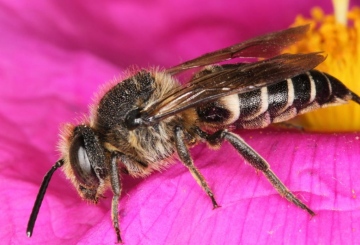  have tried adding pictures without any problem this morning, using both Mozilla and Internet Explorer, so at the moment I can only think the problem is something to do with internet connections in the north-east Essex area or problems with a specific Internet Service Provider. Please let me know if you continue to get problems and we will have to try and figure out what is happening. Peter, your Araniella photo is certainly A. cucurbitina in its old wider sense, but there are in fact two species, A. cucurbitina sensu stricto and A. opisthographa (and even a third just possible A. inconspicua) all of which are variable in colour from green, green with white to yellow, and the ONLY way of definitively identifying to species is by examination of the adult genitalia under a low power microscope. Even then some specimens can be difficult. Your other spider presents the same problem! It is a comb-footed spider Enoplognatha ovata in the old widest sense, but this is also actually 2 species in this country (4 in Europe), E. ovata sens. str. and E. latimana, which can only be distinguished by examination of adults under a low power microscope. Both species occur in the same colour forms, although in different frequencies. E. latimana is a spider of open sunny habitats and is frequent in Essex, especially near the coast, and E. ovata sens. str. also occurs in open habitats but also occurs in shady places, including woodlands etc. Wed 15th August 2012 06:39 by Peter Pearson Spiders a problem (not only spiders internet conections too) 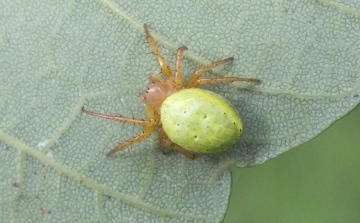 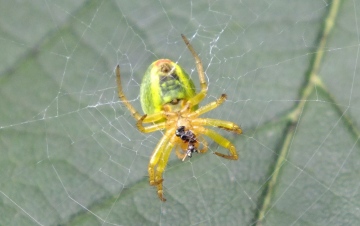 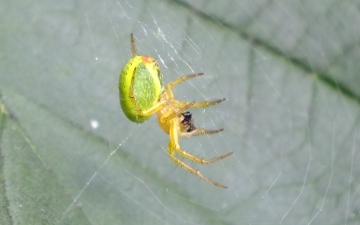 The above spider was found on a webstretched across the curled leaf of a sycamore. It was green with yellow stripes along the sides of its abdomen with four black spots on top. The legs were short with thorn like hairs. I feel fairly certain this is Araniella cucurbitna. The next spider is a little more problematical 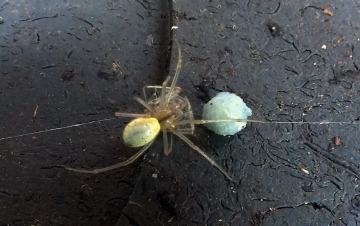 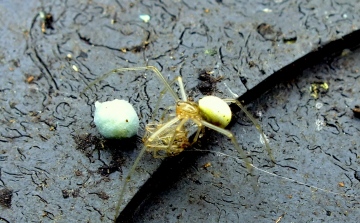 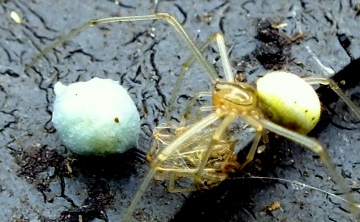 Three had taken up residence in our compost bin, where they were, no doubt taking advantage of an abundance of fruit flies. One of them was unfortunately caught in the lid of the bin when I opened it. The second disappeared and the third took up residence and produced a blue/green egg case. It had with it what appeared to be the remains of a spider encased in web which it guarded, covering it with its body. The legs of the live spider were long and glass like, the abdomen green with black spots. This could I believe be Enoplognatha ovata, but the colouration does not seem right nor does the situation it was found in. I would appreciate any comments and I.D. for these two please. Tue 14th August 2012 21:43 by Peter Pearson Spiders are a problem The first of my problem spiders was found on a web stretched across the curled leaf of a sycamore. It was green with yellow stripes along the sides of its abdomen with 4 small black spots on top. The legs were short with thorn like hairs. I feel fairly sure that this is Araniella cucurbitina. The second spider pictured below is a bit more problematical Three took up residence in our compost bin, where there was an abundance of fruit flies. One of them unfortunately met its demise when I opened the bin lid. The second disappeared. The third seemed to settle in and produced an egg mass encased in a blue/green shell. It seemed to have the remains of another sipder bound up under it which it seemed to guard closely, covering it with its body. The legs seemed long and glass like, the abomen green with black spots. Could this be a Comb Footed Spider, Enoplognatha ovata. Its appears to be the wrong colour and the situation it has taken up residence out of character. I would appreciate any commments and I.D., for these two. Mon 13th August 2012 17:14 by Graham Smith Stow Maries Aerodrome
Stow Maries 1st World War Aerodrome is up for sale for a cool £2,000,000! The owner is winding up his various businesses and moving abroad. It is a remarkable relic of that time as all the buildings - around 20-25 of them including a large number of wooden huts - have survived a hundred years of agricultural change, partly because they were useful as storage huts. Many are a bit worse for wear but are currently being restored by a dedicated band of volunteers, up to sixteen strong some days. It is now a registered historical site and it is hoped that whoever takes it on will have the means to develop its potential as a public attraction.
Several buildings have already been restored, one of which has been turned into a museum. The aerodrome was constructed in 1916 as one of a series of airfields designed to protect London from attacks by Zeppelins and Gotha long range bombers. The first commanding officer was one Lieutenant Claude Ridley, who had already seen service in France, where he had won the DSO and MC, and had also been badly wounded. He was all of 19 years old when he took up the command! They engaged Zeppelins several times but the only recorded success fell to a pilot from the nearby Goldhanger station, who downed Zeppelin L48 at Theburton in Suffolk on 17th June 1917. It did not stop the young pilots from dying though and there is a memorial to them on the green in front of the museum. Most did not succumb to enemy action but to the fragility of their aircraft, both fuselage and engines. A young Australian is recorded as saying - as he lay dying in the remains of his aircraft - "sorry chaps, but you will just have to carry on without me". They don't make them like that anymore - or do they? The aerodrome occupies a hilltop overlooking the River Crouch - a little bit of Old Essex with its scattered farms, thickly hedged byways and footpaths, and pockets of ancient woodland, including Hawes Wood, situated on the southern edge of the site. Russell Savory, who runs the place, is a corporate member of the Field Club and is transforming the site for wildlife. Among other things he has planted a wild flower meadow, a small woodland, and dug three ponds. I think he is hoping that Club members will visit the site to do some recording work. It is well worth a visit as it is very atmospheric and there is no noise from busy roads to mar the tranquility. We did a limited amount of moth trapping last year and caught several scarce Essex species including Kent Black Arches, Four-dotted Footman and Dotted Chestnut. I get there as much as I can as it is a great place to potter and to sit and contemplate one's navel. It has been a poor year for insects - wasps and hoverflies appear to be at a particularly low ebb - but butterflies have picked up with the recent rise in temperature and occasional appearance of the sun, and on my most recent visit managed to photograph Red Admiral, Comma and White-letter Hairstreak. Also this fine male Black-tailed Skimmer. They normally charge £4 for a visit but the money goes towards restoring the buildings. Another favourite haunt of mine - of 47 years standing this one - is Bradwell St Peter's. The beaches around Sales Point have become heavily eroded and the sand and shell piled ever nearer the seawall by winter storms. This has temporarily created a raised, compacted, shelf of sand abutting the wall, where a multitude of plants have become established. Recent colonists have included Sea Spurge, Sea Holly and Rock Samphire, the last two of which are not mentioned as occurring at this site in The Wild Flowers of North East Essex by Terri Tarpey and Jerry Heath. The seeds may have come from Colne Point courtesy of estuarine currents but I fear that their sojourn here may not be a long one. However, it is but a short hop - as currents go - to similar, much wider beaches adjacent to the nearby defunct Power Station. Mon 13th August 2012 14:38 by Peter Pearson Mary's tomato blight
We are not vegetable gardeners, flowers and shrubs occupy our small patch. Attempts at vegetables were abandoned years ago after we got fed up with skeleton sprouts and catapillar bored cabbages etc. (we dont used insecticides or slug pellets). We do however grow runners and tomato plants in tubs using grow bags. Last year for the first time we had blight knock out the toms. This year we tried a different position in the garden, fresh tub which was thoroughly washed and new compost. The 3 plants we had were doing fine with a superb crop coming on, then a few days ago disaster, brown spots appeared and with in a day or two the fruit was a rotting mass. The only thing we have done differently from previous years is use chicken manure pellets and we wonder if the spores are being introduced with this. Sat 11th August 2012 16:43 by Graham Smith
Michael - Thanks for the reminder. Although I am a creature of habit I will try and stay awake until the early hours if the sky is clear on one of the next two nights. The best meteor shower I ever observed was at Bradwell St Peter's some years ago. That too was in late summer - it may have been performed courtesy of the same Comet you mention. An ideal setting, Bradwell - quiet and dark - perfect for generating a sense of wonder. It is not quite the same here at Ingatestone, where the sky is illuminated by the neon lights of Brentwood and Chelmsford and the A12 composes a Stockhausen concert of internal combustion engines, especially at night and when the wind is in the wrong direction!
As for bird intelligence - I will try and match controversial comment with controversial comment. How do you measure 'intelligence'? An anthropologist recently suggested that when Neolithic Man developed the software to kill a large and formidable animal like a Woolly Mammoth, that could be termed as human progress as it provided him and his family with meat for several weeks. When he refined the software to bump off two mammoths at a time that was a further advance in progress. But when he devised the means to drive two hundred mammoths over a cliff he was a ruddy idiot unless at the same time he redesigned his hardware to cope with this new technology by learning the virtues of self restraint and switching from short term to long term planning. Fast forward to the 21st century and the need is even more pressing. So how far have we got along that road? Not very far I would suggest. Forget evolutionary theory. Most human beings merely pay lip service to it. What most of us believe is that "Evolution created man in its own image and gave him dominion over the bests of the earth". We have come to see ourselves as potential Lords of the Universe when, in reality, we can't even master our own nature! We also seem to believe (perhaps all too often encouraged in this by scientists in search of funding) that our software will always be able to come up with a technological 'fix' to save us from our every folly. Perhaps that is why we resent those scientists who state that we need to mend our ways. The science we believe in is the one that invents cures for horrible diseases or provides us with an endless succession of new toys to play with. Being told to mend our ways is the job of priests, not scientists, and no one listens to them anymore. We have come to expect a pill for every malady rather than lose weight, get more exercise and stop smoking! Which is probably why so many of us retreat into denial (or even treat the bearers of bad news as 'Quacks') when confronted with the findings of Climatologists and the like, however impeccable the science. Just how intelligent is that?!!! With regards to the walnut cracking crows in Japan which I mentioned elsewhere, I presume they devised (if that's not too strong a word) their little ploy after watching nuts that had fallen into the road naturally being cracked open by passing cars. As for the African Grey Parrot you mention, with all due respect to your wife's cousin, I reckon that if I was a highly sociable bird like a parrot and was stuck in a cage on my own I would go do-ally long before my hundred or so years on this earth were up. I once rescued an escaped Budgie from the side of a road and took it to a woman who kept a large aviary of them. After a due period of quarantine - to make sure it was not carrying a disease - she invited me back to watch it being introduced to the other birds. As we approached the aviary and it could hear the Budgies inside it became very excited and when she place its cage outside it performed around fifteen gold medal somersaults on its perch, such was its joy! On the same theme, make sure that you are not crossing a field where cattle that have spent the winter in a barn are about to be released. Excited is not the word. They prance across the field like Springboks, chasing each other's tails and rolling ecstatically in the grass. Animals know what they like. They ain't daft! Thu 9th August 2012 10:39 by Michael Daniels Meteors and a gauntlet thrown down
Some time ago, in a previous Forum, I said I would give details concerning any astronomical events likely to be
of wider interest. Up till present there has not been much to report, but always in August we have a dates that
could be worth mentioning. Of course astronomy is predominently for 'night owls' and at this time of year means
waiting up late or, Graham, used to early rising! So on this occasion, I write just two days prior to three dates
that might, reward sky-watchers. Starting on the 11th and looking upwards on the following two nights, one
could be lucky to see, without any optical aid - just reasonable eyesight - the Leonid meteor shower. This
provides examples of 'shooting stars' as they were often referred to and could, with good fortune, amount to a
memorable display, or, nothing in particular. Luck plays a considerable part in this, for a start one needs a sky
mostly clear of cloud and then a little patience. Because the Leonid meteor's appearances are usually within a
hourly rate of say up to one a minute, may be less, with just a small chance that the display could prove excep-
tional. As the sun still sets rather late and after-glow hangs around for a while after our star has slipped below
the horizon, then best to have a look after say twelve midnight. If the night continues balmy, as of recent days,
best wear a jumper and have a jacket or suchlike available in case waiting and watching is found rather a chilly
undertaking. I stress, patience is a virtue and personal comfort will encourage what could prove a worthwhile
distraction. Under any circumstances, seeing the great canopy of the heavens, is worthy of anyone's attention
at any time - a wonderful spectacle. Hope readers who can be bothered are duly rewarded. Oh yes, try and find
a place to observe away from bright artificial lights - light polution, a great bug-bear for astronomers!
Graham, yes I certainly agree about the Forum relying on a small band of writers and all those others out there reading what the few have to say, looking at interesting images, where are their contributions? Might be said 'it's the spirit of the age'! Many folk just rarely write anything, some even boast they never put 'pen to paper', have never written a letter in their lives. However, would have thought that the sort of mentality one would find amongst Essex Field Club members or those that bother to access the website, they could even just occas- sionally, make an effort. In the June Forum I even tried to introduce a bit of controvercy with my piece on avian intelligence or lack of it, thought that would excite some response from ardent bird-lovers, but only one reliable contributor had a go back - our Graham again - no one else challenged my contention. Yes, on that point I took those examples about the Blue Tits opening milk tops, we had them do that to our bottles, and, the instance of the Japanese birds using road traffic to crush nuts, remarkable. I still hold to my views on avain level of intellect, reinforced by watching their stupid behaviour in our garden, and certainly not impressed by watching my wife's cousin's African Grey parrot when they bring him with them when they visit. He'd certainly ready to bite the hand that feeds him and dose! And all his idle repetitive chat they truly think is indicative of his intelligence - I think not. But maybe there are clever birds about and thus one is reminded of what Shakespere wrote in Hamlet, er, the words duly adapted - there are more things in heaven and earth, than in all our understanding. Wed 8th August 2012 15:39 by Graham Smith Spruce (Gooseberry) Brittlegill Russula queletii
Ingatestone & Fryerning Fungi No. 1 Spruce Brittlegill Russual queletii.
Location : Ingatestone Garden Centre. TQ637982. Growing under Picea abies Norway Spruce in a redundant Christmas Tree Plantation. July 2012 Description : Cap - 2-4(6)cm. Dark purple-maroon; greasy and shiny when wet, rapidly drying to matt brownish-purple. Surface uneven, almost lumpy with age, and looks porous (ie : covered with minute pores) under a X10 lens. Margin smooth when young, slightly sulcate when older. Cuticle peels to half way. Gills - white or very pale cream, depending on age; adnate, not crowded, edge smooth. Stipe - 4-5cm, broadening below (occasionally clavate) and rounded at base. Slightly fibrillose. Flushed deep purple-red throughout but covered in a whitish pruinescence when fresh, this eventually retreating upwards. Slightly paler at base. Firm when young. Flesh - white, but purple-red immediately below cap cuticle or where damaged. Taste- slowly turning very acrid. Smell - fruity - or so I'm told! Spore Print - pale cream (B-C on Geoffrey Kibby's chart). Spores - 7-8.5 x 6-7.5um. Covered in large isolated warts (X800OEL). No further microscopic analysis possible as I lack the chemicals to do so. Similar species : Russula fuscorubroides. Very rare. Grows under both Pinus and Picea. Gills are cream to deep cream and spore print deep cream to pale ochre (D-F on Geoffrey's chart). Critical feature is dermocystidia in cap but was unable to examine these. Russula sardonia. Grows under Pinus. Gills pale cream and spore print deep cream. Stipe paler. A regular at Fryerning Churchyard. Status : There's the rub! There appear to be no records for Essex on the Field Mycology database. Collection No. : Ingatestone & Fryerning Fungi 1. Ingatestone Garden Centre. TQ637982. July 14th 2012. Tue 7th August 2012 20:41 by Peter Pearson Wind power Ancient and Modern Sat 4th August 2012 16:37 by Mary Smith Three unusual events in my garden (not counting giant slugs)
Three unusual events in my garden I have noticed in the last couple of days.
All my tomato plants, every single last one of the 45 I planted out, are dying of blight. I will not get one tomato this year. First year of total failure! We have been here since 1966, when we moved in. I have several plants of Enchanter's-nightshade in my rose bed. This plant is an ancient woodland indicator. Now, what does this say about my rose bed? And no, there are no trees in it nor shrubs except for a few struggling roses. Any suggestions? Autumn last year a strange plant was growing in the old potato patch. I did not know what it was, though I guessed it to be in the Knapweed group. So I moved it to where I could watch it, and it has produced well over 30 stems of purple flowers of Common Knapweed. I do not know whence it came, but it must have been a whole flowerhead that landed and every seed grew. Not wishing my garden to be over-run with these next year, I tried to dig out the root, having first cut off all stems. Wow! What a job that was! With a 50cm tap root, and many subsidiaries, it has taken me over an hour to get it all out! And did you know that we have had rainfall here much more than a whole year's worth in a normal year, actually closer to double a year's worth, and we are only 7 months in. No wonder there are giant slugs, huge Knapweeds, rotting tomatoes etc. Fri 3rd August 2012 20:58 by Peter Pearson Arion rufus var. giganteus
Graham Thanks for the identification of the slug that has been pestering my meagre efforts at runner growing. I thought they were just the normal Arion slugs but you have solved the problem, obviously they are spreading across the county. Thu 2nd August 2012 15:50 by Graham Smith Birds in Chimney
Mary - my observations come from a lifetime spent gazing skywards instead of doing something useful! Sorry to bombard you with pictures of fungi but as you know I always defer to you and Tony! I put such pieces on here to try and generate a bit of interest as after all the work Peter has put in on it I want this website (including this forum) to be a success. At the moment it appears to be a private conversation between four of us and I am beginning to despair! Where are all the other Club members? Lost among special interest groups perhaps? A shame, as it could be a great medium for simply swapping notes on finds etc; scientifically based, sure, but also a way of expressing delight in the world around you. Anyway, I thoroughly enjoy everyone's contributions - small in number as we are. I attach a photo of a creature that delighted me (kind of) this week. It is a new race of the Large Red Slug, named by yours truly as Arion rufus var. giganteus. It only achieves this size after a summer spent gorging on runner beans, mange tout, beetroot and lettuce - my runner beans, mange tout, beetroot and lettuce to be precise! Cheers.
|
Archives: May 2020Aug 2019 Jan 2019 Sep 2018 Jul 2016 Oct 2015 Jul 2015 May 2015 Apr 2015 Mar 2015 Feb 2015 Jan 2015 Dec 2014 Oct 2014 Sep 2014 Aug 2014 Jul 2014 May 2014 Apr 2014 Mar 2014 Feb 2014 Jan 2014 Dec 2013 Nov 2013 Sep 2013 Aug 2013 Jul 2013 Jun 2013 May 2013 Apr 2013 Mar 2013 Feb 2013 Jan 2013 Dec 2012 Nov 2012 Oct 2012 Sep 2012 Aug 2012 Jul 2012 Jun 2012 May 2012 Apr 2012 Mar 2012 Feb 2012 Jan 2012 Dec 2011 Nov 2011 Oct 2011 Sep 2011 Aug 2011 Jul 2011 Jun 2011 May 2011 Apr 2011 Mar 2011 Feb 2011 Jan 2011 Dec 2010 Nov 2010 Oct 2010 Sep 2010 Aug 2010 Jul 2010 Jun 2010 May 2010 Apr 2010 Mar 2010 Feb 2010 Nov 2009 Oct 2009 Aug 2009 Jul 2009 Jun 2009 May 2009 Apr 2009 Mar 2009 Feb 2009 Jan 2009 Nov 2008 Oct 2008 Sep 2008 Aug 2008 Jul 2008 Jun 2008 May 2008 Apr 2008 Mar 2008 Feb 2008 Jan 2008 Dec 2007 Nov 2007 current posts |



















